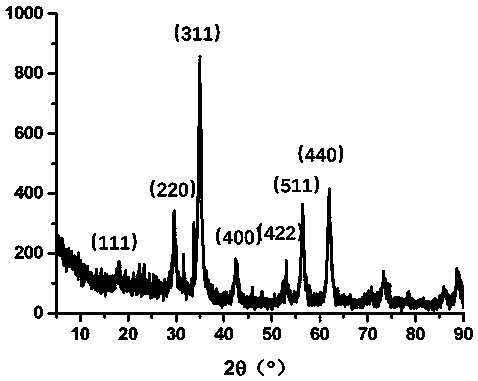Preparation method of detection probe for alpha-synuclein accumulation as well as product and application of detection probe
A synuclein and detection probe technology, applied in the field of biological detection, to achieve the effects of small particle size, high biological safety, and good catalytic activity
- Summary
- Abstract
- Description
- Claims
- Application Information
AI Technical Summary
Problems solved by technology
Method used
Image
Examples
Embodiment 1
[0033] 1. Magnetic Fe3O4 nanoparticles (Fe 3 o 4 NPs) particle generation and surface amination modification.
[0034] Synthesis of Particle Size Fe by Chemical Co-precipitation 3 o 4 NPs: Weigh 0.6 g of FeCl 3 and 0.38 g FeSO 4, dissolved in 50 mL deionized water. 20 mL of 1.5 M NaOH was quickly added to the iron-containing solution, and stirred at room temperature for 10 min. The black precipitate was washed with ethanol and dried under vacuum overnight. Weigh an appropriate amount of Fe 3 o 4 NPs were characterized by XRD, with figure 1 It can be seen that the 2θ values are 30.3︒, 35.7︒, 43.5︒, 53.9︒, 57.5︒, and 63.2︒, and there are 6 obvious diffraction peaks, whose positions are similar to those of Fe 3 o 4 The NPs can be well matched, corresponding to the (220), (311), (400), (422), (511) and (440) crystal planes of the cubic crystal phase, respectively.
[0035] Fe 3 o 4 NPs@SiO 2 Synthesis: 2.0 mg Fe 3 o 4 NPs were dispersed in 10 mL of cyclohe...
Embodiment 2
[0041] 1. Magnetic Fe3O4 nanoparticles (Fe 3 o 4 NPs) particle generation and surface amination modification.
[0042] Synthesis of Particle Size Fe by Chemical Co-precipitation 3 o 4 NPs: 0.6 g of FeCl 3 and 0.38g FeSO 4 , dissolved in 50 mL deionized water. 20 mL of 1.5 M NaOH was quickly added to the iron-containing solution, and stirred at room temperature for 10 min. The black precipitate was washed with ethanol and dried under vacuum overnight.
[0043] Fe 3 o 4 NPs@SiO 2 Synthesis: 2.0 mg Fe 3 o 4 NPs were dispersed in 10 mL of cyclohexane at room temperature, followed by 1.8 g Triton-X 100, 1.6 mL n-hexanol and 0.34 mL H 2 O was added to the above solution with stirring to form an inverse microemulsion. After 15 min, add 40 μL TEOS to the microemulsion, and after 30 min, add 0.1 mL of 28% ammonia water to the above mixture. After 24 h, ethanol precipitates Fe 3 o 4 NPs@SiO 2 Nanoparticles. Fe 3 o 4 NPs@SiO 2 The nanoparticles were separated by...
Embodiment 3
[0048] 1. Magnetic Fe3O4 nanoparticles (Fe 3 o 4 NPs) particle generation and surface amination modification.
[0049] Synthesis of 200 nm Fe by Hydrothermal Method 3 o 4 NPs: 1.35g FeCl 3 Dissolve in 40 mL ethylene glycol and stir evenly to form a bright yellow solution. 3.6 g Na Ac and 1.0 g PEG were added to the solution and stirred at room temperature for 30 min. The mixed solution was transferred into a reaction kettle and reacted at 200°C for 18 hr. The resulting black precipitate was washed with ethanol and dried under vacuum overnight.
[0050] Fe 3 o 4 NPs@SiO 2 Synthesis: 2.0 mg Fe 3 o 4 NPs were dispersed in 10 mL of cyclohexane at room temperature, followed by 1.8 g Triton-X 100, 1.6 mL n-hexanol and 0.34 mL H 2 O was added to the above solution with stirring to form an inverse microemulsion. After 15 min, add 40 μL TEOS to the microemulsion, and after 30 min, add 0.1 mL of 28% ammonia water to the above mixture. After 24 h, ethanol precipitates F...
PUM
| Property | Measurement | Unit |
|---|---|---|
| particle diameter | aaaaa | aaaaa |
| size | aaaaa | aaaaa |
| thickness | aaaaa | aaaaa |
Abstract
Description
Claims
Application Information
 Login to View More
Login to View More - R&D
- Intellectual Property
- Life Sciences
- Materials
- Tech Scout
- Unparalleled Data Quality
- Higher Quality Content
- 60% Fewer Hallucinations
Browse by: Latest US Patents, China's latest patents, Technical Efficacy Thesaurus, Application Domain, Technology Topic, Popular Technical Reports.
© 2025 PatSnap. All rights reserved.Legal|Privacy policy|Modern Slavery Act Transparency Statement|Sitemap|About US| Contact US: help@patsnap.com



